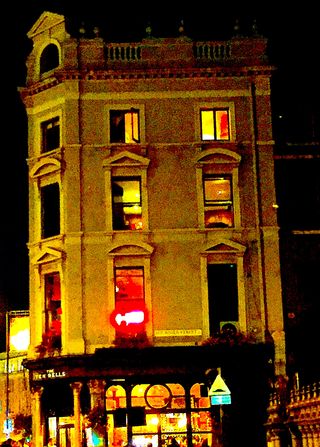Law and Crime
Murder Walks
The true crime obsession inspires the launch of murder tours.
Posted October 9, 2019

In the news recently, I saw ads promoting a "Murder Walk" in Austin, Texas, to show the places where “America’s First Serial Killer” terrorized the city. (Not really the first, but the first documented one in an American city.) The yearlong unsolved series in 1884-85 was even linked by a journalist during that era to Jack the Ripper.
The tour supposedly “retraces the steps of the killer.” Tour operator and history professor Jim Miles admits that he’s tapping into the true-crime trend, but he hopes he can also provide a unique view of Austin’s history. He starts near the spot where the first murder occurred.
When I researched murder tours, I was surprised to see how many had popped up recently in large cities. Generally, it’s easy to find ghost tours, but “murder walks” or bus tours (even a tour by hearse) have now become a thing. It’s probably due to the intense fascination we’ve seen with true crime. People aren’t content with listening to podcasts or bingeing the various TC-dedicated networks. They want to experience these places.
I discussed some reasons here, noting that at such places, there’s a heightened sense of suspense and thrill. Similar to Civil War reenactors or people who want to stay overnight in haunted abodes, murder tourists seek that frisson that comes from the echo of intensely dramatic emotion. They want to be close to where Andrew Cunanan killed Gianni Versace (South Beach), or where Lizzie Borden’s father and stepmother were slaughtered with an ax.
In some places, they can even book a room. I suspect that certain aspects of murder tourism are simply about feeling our own mortality. We're also curious about what could spark a murderous rage or how someone could live with bodies in his home.
Speaking of Jeffrey Dahmer, certain tours elicit outrage from locals and victims’ family members. When the Jeffrey Dahmer Murder Tour was announced in Milwaukee, Wisconsin, a few years ago, residents called it offensive. The apartment building where Dahmer had dismembered most of his victims and stored body parts is long gone, but you can still see places where he hunted for potential victims. This tour is about getting inside his head.
“Guides march guests through the grisly corridors of Jeffrey Dahmer’s life and killing spree,” the tour ad had stated, “as they narrate the triggers of his psychosis and the heinous crimes he committed.” The tour company insisted it was educational, citing school programs that had contacted them to set up a tour.
Still, it seems that older crimes, like the Borden double homicide in Fall River, the LaLaurie mansion in New Orleans, or the Villisca massacre house in Iowa, are more tolerable for featuring on tours. These crimes all happened over a century ago.
And despite protests, the murder tours proceed.
In 1996, Andrew Roth published Infamous Manhattan, which offered a self-guided walking history of crime scenes in New York. You could find such places as the “wickedest house on the wickedest street,” where architect Stanford White was killed, or the infamous murder of Helen Jewett occurred. Such tours were pretty rare back then, but now you can sign up for specialist tours like the New York Mafia Tour, or if you’d prefer to ride, take the hearse for the Dead Apple Tour, which encompasses New York’s most interesting deaths (not all murders).
In Los Angeles, you have the Tragical History Tour (great title), the Helter Skelter Tour, the Dearly Departed Tour, and the Black Dahlia Tour. Given that LA is a car-sodden city, you probably don’t get to walk much. These tours go by van or bus.
Like Dahmer’s apartment building, the “murder castle” that H. H. Holmes built was burned down back in the 1890s, but there’s a Devil in the White City tour in Chicago that talks about his nefarious frauds and clandestine murders, mostly of young women. (It’s partly bus and partly walking.)
In London, you get more Jack the Ripper Tours than you can shake a knife at, and there’s also a “Murder Mile Tour” featuring 12 murderers at 15 locations. You learn about Dennis Nilsen, the Blackout Ripper, and the Soho Strangler. Across the Channel, Paris, too, has a “Dark Heart and Murder Mysteries” tour.
In Boston, you can walk around and see the city’s crime history, including Boston Strangler locations, or go to Cleveland for the "Torso Murder Tour." Even Detroit offers the "Notorious 313 True Crime & Ghost Tour."
I once mapped out a murder walk in Savannah’s historic district, which you can do yourself with a little research, starting with Jim Williams’ majestic mansion, where he killed Danny Hansford. Not far away, Charleston has an interactive Whodunit Murder Mystery Game tour, touted as a “mystery with a little history.” Speaking of history, Williamsburg hosts the “Extreme Murder Tour and Pub Crawl,” the only tour in the area, they say, dedicated exclusively to murder (includes ghosts). You even get murder-themed cocktails.
Murder is nothing to laugh about, of course, but some of these tales have historical value, and some enlighten us about human nature. The murder walks I’ve taken seem to be an extension of the crime museums that once graced many cities, set up by criminologists to educate us. Some people might go to just gawk, but this doesn’t erase a tour's value to inform.




